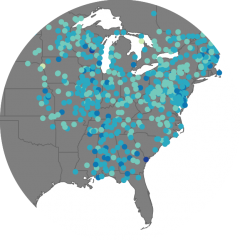Understanding impacts of anthropogenic change
Species are experiencing multiple sources of anthropogenic influence on their environment, including climate and land use changes. I am interested in understanding how these drivers interact to synergistically impact species populations and community composition, using North American breeding birds to examine these topics at continental scales. In particular, my work in this area explores the interactive effects of land use and climate change, the scale at which different drivers best explain community compositional shifts, and how species traits may impact the direction and magnitude of their responses to global change.
Using citizen science to monitor biodiversity
The availability of biodiversity records to monitor species has grown exponentially through the growth of citizen science platforms. Whether and how these data can be used to track distributions and phenology requires an understanding of how citizen science projects are designed and how users participate in these platforms. I am interested in how users behave on citizen science platforms such as iNaturalist, and how structured or unstructured citizen science projects can be used to understand how species are responding to changing climates. Work on this topic has been completed as part of the NSF-funded Phenomismatch project and the Caterpillars Count! citizen science project.
Watch an outreach talk on this work as part of the NC Museum of Natural Sciences’ Lunchtime Discover series here.
Macroecological patterns describing species richness
Spatial patterns in global biodiversity such as the latitudinal biodiversity gradient or productivity-richness relationships have been observed across ecosystems and taxonomic groups, with many alternative hypotheses proposed as explanations. I am interested in how we can develop rigorous tests of possible explanations for these patterns such that it is possible to distinguish between hypotheses, and I have considered this issue most recently in testing alternative explanations for positive productivity-richness relationships in vertebrates.
